
Canidae is a biological family of dog-like carnivorans, colloquially referred to as dogs, and constitutes a clade. A member of this family is also called a canid. There are three subfamilies found within the canid family, which are the extinct Borophaginae and Hesperocyoninae, and the extant Caninae. The Caninae are known as canines, and include domestic dogs, wolves, coyotes, foxes, jackals and other extant and extinct species.
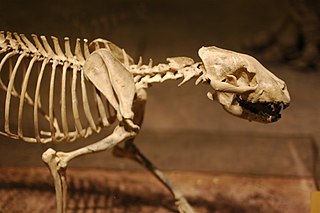
The extinct Borophaginae form one of three subfamilies found within the canid family. The other two canid subfamilies are the extinct Hesperocyoninae and extant Caninae. Borophaginae, called "bone-crushing dogs", were endemic to North America during the Oligocene to Pliocene and lived roughly 34—2.5 million years ago, existing for about 33.5 million years.

Hesperocyon is an extinct genus of canids that was endemic to North America, ranging from southern Canada to Colorado. It appeared during the Uintan age, –Bridgerian age (NALMA) of the Mid-Eocene– 42.5 Ma to 31.0 Ma. (AEO). Hesperocyon existed for approximately 11.5 million years.

Cynodesmus is an extinct genus of omnivorous canine which inhabited North America during the Oligocene living from 33.3—-26.3 Ma and existed for approximately 7 million years.

The Caninae, known as canines, are one of three subfamilies found within the canid family. The other two canid subfamilies are the extinct Borophaginae and Hesperocyoninae. The Caninae includes all living canids and their most recent fossil relatives. Their fossils were first found in North America and dated to the Oligocene era, then spreading to Asia at the end of the Miocene era, some 7 million to 8 million years ago.

The extinct Hesperocyoninae are one of three subfamilies found within the canid family. The other two canid subfamilies are the extinct Borophaginae and extant Caninae.
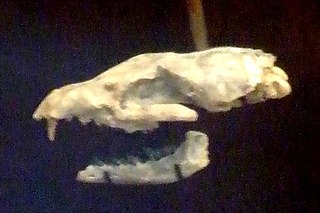
Archaeocyon is an extinct genus of the Borophaginae subfamily of canids native to North America. It lived during the Oligocene epoch 32-24 Ma., existing for approximately 8 million years. Species of Archaeocyon are among the earliest known borophagines, although a species of Otarocyon has a slightly earlier first appearance. Fossils have been found across the northern Great Plains and along the west coast of North America.
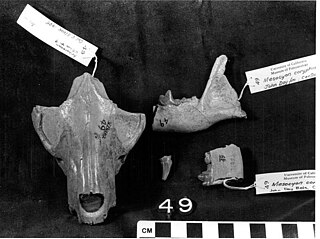
Mesocyon is an extinct genus of the Hesperocyoninae subfamily of early canids native to North America. It lived from the Oligocene to Early Miocene, 30.3—20.3 Ma, existing for approximately 10 million years. Fossils are known from Oregon, southern California and the northern Great Plains. It was roughly coyote-sized, and the first known canid to have a primarily meat-based diet.

Enhydrocyon is an extinct genus of bone crushing canid which inhabited North America during the Oligocene and Early Miocene, 30.8—20.4 Ma, existing for approximately 11 million years.
Ectopocynus is an extinct genus of bone crushing canid which inhabited North America from the Oligocene to the Early Miocene. It lived from 33.3 to 16.0 Ma and existed for approximately 17.3 million years.
Caedocyon is an extinct monospecific genus of bone crushing canid which inhabited western North America during the Oligocene 30.8—20.6 Ma, existing for approximately 10.2 million years.
Prohesperocyon is an extinct genus of the first canid endemic to North America appearing during the Late Eocene around 36.6 mya (AEO).
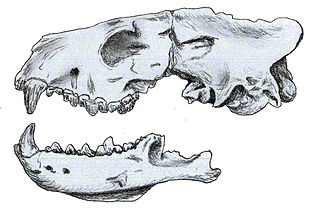
Philotrox is an extinct monospecific genus of the Hesperocyoninae subfamily of early canids native to North America. It lived during the Oligocene, 30.8—26.3 Ma, existing for approximately 5 million years. In form, it was intermediate between the small Cynodesmus and the later Enhydrocyon, the first hypercarnivorous, "bone-cracking", canid.
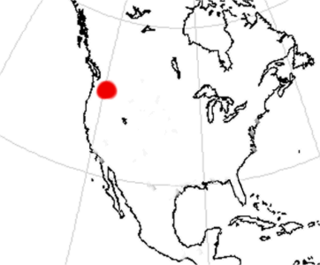
Rhizocyon is an early member of the subfamily Borophaginae, an extinct subgroup of canids that were endemic to western North America during the Oligocene epoch, living from ~31—24.5 Ma., existing for approximately 6.5 million years.

Desmocyon is an extinct genus of the Borophaginae subfamily of canids native to North America. It lived from the Late Oligocene to the Early Miocene, 24.8—16.3 Mya, existing for approximately 8.5 mya. It is a rarely found genus, with fossil deposits only occurring in western Nebraska, Wyoming, New Mexico and north Florida. It is regarded as a primitive, transitional member of the Borophagini tribe.
Euoplocyon is an extinct genus of the Borophaginae subfamily of canids native to North America. It lived during the Early to Middle Miocene, 20.6—13.6 Mya, existing for about 7 million years. A member of the Borophagini tribe, it was an intermediate-sized canid, with specialisations towards a heavily meat-based diet.
Cynarctina is an extinct clade of the Borophaginae subfamily of canids native to North America. They lived from the Early to Middle Miocene 16.0—10.3 Ma, existing for approximately 5.7 million years. Cynarctines had rounded cusps on the molar teeth, similar to those seen in living bears, suggesting that they were likely omnivores.

Tephrocyon is an extinct genus of the Borophaginae subfamily of canids native to North America. They lived during the Barstovian stage of the Middle Miocene 16.3—13.6 million years ago, existing for roughly 2.7 million years. It is a rarely found genus, with fossil deposits only occurring in western Nebraska, Wyoming, eastern Oregon, New Mexico, and north Florida. It was an intermediate-sized canid, and more predatory than earlier borophagines.

Cerdocyonina is an extant subtribe of the canines and is exclusively endemic to the Americas. Often described to be "fox-like" in appearance and behavior, they are more closely related to the wolf-like canids such as Canis than they are to the fox genus Vulpes. Its members are colloquially known as the South American canids and there are 10 extant species. They are sometimes referred to as South American foxes in the older literature, but the term zorro has been recommended by mammalogists to avoid confusion with the true foxes of the tribe Vulpini, which includes the genus Vulpes.














